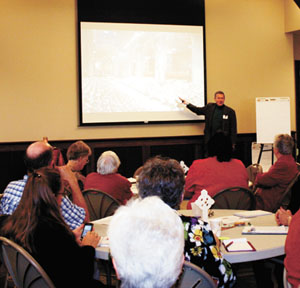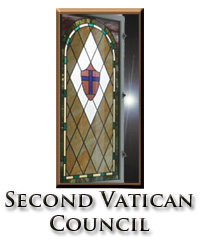By Barb Arland-Fye

IOWA CITY — Participants in a daylong workshop on Vatican II received this assignment from presenter Bill Huebsch: teach about Vatican II in your homes and parishes, and embrace the council’s theme of a universal call to holiness.
The workshop at St. Patrick Parish in Iowa City Oct. 23 drew nearly 200 individuals from throughout the Davenport Diocese and beyond who were eager to learn how to tap into the spirit of Vatican II. Huebsch, who directs the work of the Vatican II Center at PastoralPlanning.com and 23rd Publications, kept his audience engaged with humor, history and insights from years of studying the Second Vatican Council.
He noted that Pope John XXIII, in calling for the council in 1959, wanted the Church to return to its sources (ressourcement) to learn from them. At the same time, the pope didn’t want to simply “pluck practices out of the first century and plop them down here in our time,” Huebsch said. Pope John thought the Church needed updating and to read the signs of the times, or “aggiornamento.”
So what did the council recover? The fact that all baptized people are called to ministry, the restoration of Scripture, the Rite of Christian Initiation of Adults (RCIA), the understanding of solidarity with the poor, and the call to holiness expressed in the Constitution on the Church. The call to holiness “became a leitmotif throughout the council documents,” Huebsch observed. “This leads us to being an adult Church, with lifelong learning and with the end in mind to transform the world in Christ.”
Huebsch sees the work of the Holy Spirit in every aspect of the council — from the accidental seating chart of the world’s bishops (which exposed them to the Church’s diversity) to “illegal” rooftop parties in Rome. Those parties of clergy and laity followed evening lectures in which theologians expounded on ground-breaking issues.
The world’s bishops were the heroes of Vatican II for crafting 16 official documents, four great constitutions, nine decrees and three declarations, Huebsch said. No one was condemned and no new doctrines were defined. “The Holy Spirit really moved the Church during the council! We are living in an age when the Spirit is bringing new energy to us all. We can’t ignore this.”
Teach about Vatican II to parishioners of all ages, he urged the participants, but don’t make it complicated. Instruction doesn’t require creation of a new curriculum, but rather incorporation into an existing faith formation program. “Help your learners see what happened. It’s a great story,” Huebsch advised. He personally believes that more resources ought to be devoted to adult catechesis because if the adults don’t get it, their children won’t, either.
 He offered a variety of resources to help participants become more familiar with the work of Vatican II: books, such as “Vatican Council II” (Austin Flannery, OP, general editor); “Vatican II in Plain English” (by Huebsch); “Keys to the Council,” by Richard Gaillardetz and Catherine Clifford; “What Happened at Vatican II?” by John O’Malley; and the “History of Vatican II,” edited by Giuseppe Alberigo and Joseph Komonchak. E-resources are also available through PastoralPlanning.com.
He offered a variety of resources to help participants become more familiar with the work of Vatican II: books, such as “Vatican Council II” (Austin Flannery, OP, general editor); “Vatican II in Plain English” (by Huebsch); “Keys to the Council,” by Richard Gaillardetz and Catherine Clifford; “What Happened at Vatican II?” by John O’Malley; and the “History of Vatican II,” edited by Giuseppe Alberigo and Joseph Komonchak. E-resources are also available through PastoralPlanning.com.
Small-group faith formation is as important as resources provided; conversion comes before catechesis, Huebsch noted. “When you open the door, God will do the rest of the work.”
He urged workshop participants to help people live out their own call to holiness through personal witness. He told the clergy in the audience that their personal witness is crucial. “We don’t need to just hear what the readings mean; we need to know how they touch your lives.”
Huebsch said implementing Vatican II will happen when “we encounter Christ, we join in his paschal mystery, we hear his voice echo in our depths, and we become his body today, feeding the poor, loving the vulnerable and being Christ for the world.”







